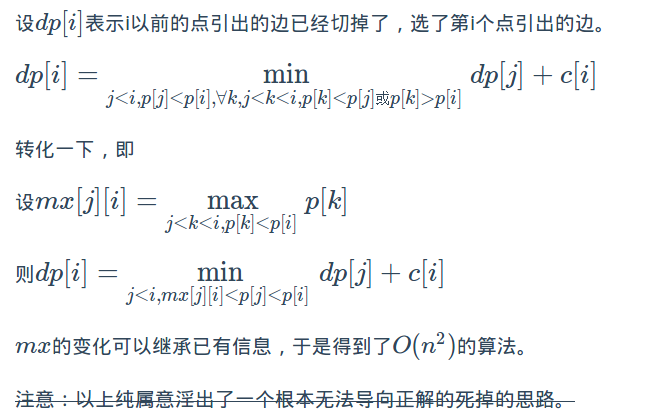2021.7.15考试总结[NOIP模拟16]
ZJ模拟D2就是NB。。
T1 Star Way To Heaven
谁能想到这竟是个最小生成树呢?(T1挂分100的高人JYF就在我身边
把上边界和下边界看成一个点和星星跑最小生成树,从上边界开始跑到下边界,一定会出现一条将矩阵纵向一分为二的折线,其中线段都是最小距离,答案就是其中最长的线段的一半。
我直呼NB
由于这是个完全图,kruscal比prim多个log,会炸。
code:

1 #include<bits/stdc++.h> 2 #define debug exit(0) 3 using namespace std; 4 const double eps=1e-8; 5 const int NN=6e3+5; 6 int n,m,k,nod; 7 double ans,dis[NN],x[NN],y[NN]; 8 bool vis[NN]; 9 inline int read(){ 10 int x=0,f=1; 11 char ch=getchar(); 12 while(ch<'0'||ch>'9'){ 13 if(ch=='-') f=-1; 14 ch=getchar(); 15 } 16 while(ch>='0'&&ch<='9'){ 17 x=(x<<1)+(x<<3)+(ch^48); 18 ch=getchar(); 19 } 20 return x*f; 21 } 22 double ds(int a,int b){ 23 return sqrt(1.0*(x[a]-x[b])*(x[a]-x[b])+(y[a]-y[b])*(y[a]-y[b])); 24 } 25 int main(){ 26 n=read(); m=read(); k=read(); 27 for(int i=1;i<=k;i++) 28 x[i]=read(), y[i]=read(); 29 for(int i=1;i<=k;i++) 30 dis[i]=m-y[i]; 31 dis[k+1]=m; dis[0]=1e9; 32 while(1){ 33 int to=0; 34 for(int i=1;i<=k+1;i++) 35 if(!vis[i]&&dis[i]<dis[to]) to=i; 36 ans=max(ans,dis[to]); vis[to]=1; 37 if(to==k+1){ 38 printf("%.8lf\n",ans/2); 39 return 0; 40 } 41 for(int i=1;i<=k;i++) 42 dis[i]=min(dis[i],ds(i,to)); 43 dis[k+1]=min(dis[k+1],1.0*y[to]); 44 } 45 }
T2 God Knows
用B哥的话说,第一眼DP,第二眼不会。
看这题满脑子状压,但数据范围无情地把我拉回现实。
又想了一会树规,但假了。无奈之下,还是不想打状压,一调一小时于是果断糊了个DFS拿了20。
正解是个NB东西。把p看作带权序列,问题转化成求最小权极长上升子序列。

n2无法过掉,考虑神仙优化。如何优化呢?
万能的线段树!
发现能更新dpi的j满足它的p是从j到i中所有小于pi的最大值,但仍难以维护。
于是可以在线段树中维护以p为下标,i为关键值的一个单调栈。那么又到了我不懂的东西。
在每个节点上维护一个单调栈,记录栈底元素(i最大值),其中最小的权值(即为dp数组),和左儿子被右儿子最大值更新后的最小权值。
写一个cal函数计算当前节点的栈中加入关键值为val的元素后的最小权值。
用一个nxt计接下来要向栈中压进的元素,因为要把右儿子栈底压进左边,每次查询先询问右边来得到接下来询问范围。
code:

1 #include<bits/stdc++.h> 2 #define ld rt<<1 3 #define rd (rt<<1)|1 4 #define debug exit(0) 5 using namespace std; 6 const int NN=2e5+5,inf=2e9; 7 int n,p[NN],c[NN],nxt; 8 inline int Min(int a,int b){ return a<b?a:b; } 9 inline int Max(int a,int b){ return a<b?b:a; } 10 inline int read(){ 11 int x=0,f=1; 12 char ch=getchar(); 13 while(ch<'0'||ch>'9'){ 14 if(ch=='-') f=-1; 15 ch=getchar(); 16 } 17 while(ch>='0'&&ch<='9'){ 18 x=(x<<1)+(x<<3)+(ch^48); 19 ch=getchar(); 20 } 21 return x*f; 22 } 23 void write(int x){ 24 if(x<0) putchar('-'), x=-x; 25 if(x>9) write(x/10); 26 putchar(x%10+'0'); 27 } 28 struct segment_tree{ 29 int l[NN<<2],r[NN<<2],mn[NN<<2],um[NN<<2],mx[NN<<2]; 30 int cal(int rt,int val){ 31 if(l[rt]==r[rt]) return mx[rt]>val?mn[rt]:inf; 32 if(mx[rd]>val) return Min(um[ld],cal(rd,val)); 33 return cal(ld,val); 34 } 35 void pushup(int rt){ 36 mx[rt]=Max(mx[ld],mx[rd]); 37 mn[rt]=Min(mn[rd],um[ld]=cal(ld,mx[rd])); 38 } 39 void build(int rt,int opl,int opr){ 40 l[rt]=opl; r[rt]=opr; 41 mn[rt]=um[rt]=inf; mx[rt]=-1; 42 if(opl==opr) return; 43 int mid=opl+opr>>1; 44 build(ld,opl,mid); build(rd,mid+1,opr); 45 } 46 int query(int rt,int opl,int opr){ 47 if(l[rt]>=opl&&r[rt]<=opr){ 48 int ans=cal(rt,nxt); 49 nxt=Max(nxt,mx[rt]); 50 return ans; 51 } 52 int mid=l[rt]+r[rt]>>1,ans=inf; 53 if(opr>mid) ans=Min(ans,query(rd,opl,opr)); 54 if(opl<=mid) ans=Min(ans,query(ld,opl,opr)); 55 return ans; 56 } 57 void insert(int rt,int pos,int i,int val){ 58 if(l[rt]==r[rt]){ mn[rt]=val; mx[rt]=i; return; } 59 int mid=l[rt]+r[rt]>>1; 60 if(pos<=mid) insert(ld,pos,i,val); 61 else insert(rd,pos,i,val); 62 pushup(rt); 63 } 64 }s; 65 int main(){ 66 n=read(); 67 for(int i=1;i<=n;i++) p[i]=read(); 68 for(int i=1;i<=n;i++) c[i]=read(); 69 ++n; p[n]=n; s.build(1,0,n); s.insert(1,0,0,0); 70 for(int i=1;i<=n;i++){ 71 nxt=-1; 72 int tmp=s.query(1,0,p[i]-1)+c[i]; 73 s.insert(1,p[i],i,tmp); 74 if(i==n) write(tmp), putchar('\n'); 75 } 76 return 0; 77 }
T3 Lost My Music
一看就是个斜率,但我没学
用单调栈(可持久化)维护一个下凸包,每次求凸包切线。
暴力弹栈会炸,于是学着用了个倍增。代码挺短
贴个斜率优化博客
code:

1 #include<bits/stdc++.h> 2 #define debug exit(0) 3 using namespace std; 4 const double eps=1e-8; 5 const int NN=5e5+5; 6 int n,fa[NN][21],to[NN],nex[NN],head[NN],num,dep[NN],ans[NN],c[NN]; 7 inline int read(){ 8 int x=0,f=1; 9 char ch=getchar(); 10 while(ch<'0'||ch>'9'){ 11 if(ch=='-') f=-1; 12 ch=getchar(); 13 } 14 while(ch>='0'&&ch<='9'){ 15 x=(x<<1)+(x<<3)+(ch^48); 16 ch=getchar(); 17 } 18 return x*f; 19 } 20 inline void add(int a,int b){ 21 to[++num]=b; nex[num]=head[a]; head[a]=num; 22 } 23 inline double Min(double a,double b){ 24 return a<b?a:b; 25 } 26 inline double calc(int x,int y){ 27 return 1.0*(c[y]-c[x])/(dep[x]-dep[y]); 28 } 29 void dfs(int st){ 30 int father=fa[st][0]; 31 for(int i=19;i>=0;i--){ 32 if(fa[father][i]<2) continue; 33 if(calc(st,fa[father][i])>=calc(st,fa[fa[father][i]][0])) father=fa[father][i]; 34 } 35 if(calc(st,father)>=calc(st,fa[father][0])&&father>1) father=fa[father][0]; 36 ans[st]=fa[st][0]=father; 37 for(int i=1;i<=19;i++) 38 fa[st][i]=fa[fa[st][i-1]][i-1]; 39 for(int i=head[st];i;i=nex[i]){ 40 dep[to[i]]=dep[st]+1; 41 dfs(to[i]); 42 } 43 } 44 int main(){ 45 n=read(); 46 for(int i=1;i<=n;i++) c[i]=read(); 47 for(int i=2;i<=n;i++){ 48 fa[i][0]=read(); 49 ans[i]=1e9+1e7; 50 add(fa[i][0],i); 51 } 52 dfs(1); 53 for(int i=2;i<=n;i++) 54 printf("%.10lf\n",calc(i,ans[i])); 55 return 0; 56 }



 浙公网安备 33010602011771号
浙公网安备 33010602011771号